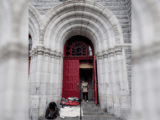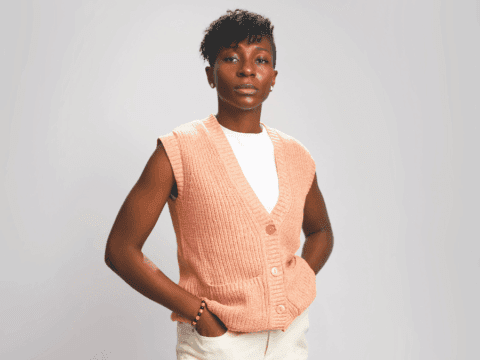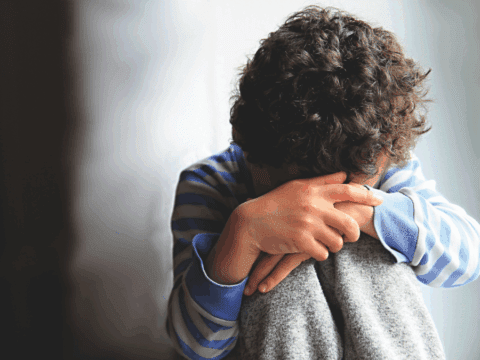The entrance to the low-slung brick building that was once the Prince Edward Island Hospital in Charlottetown is sealed tight with particleboard. Many of the windows are also boarded up, although some boast unbroken glass. A few ancient air conditioners jut out, hinting at warmer days.
Nicole* pulls up her hood to block the biting February wind and turns toward the building, a remnant of a story she hasn’t told many people before. The traumatic experience left her scarred. “Not the actual abortion,” she confides. “But everything I had to go through to get it.”
You may unsubscribe from any of our newsletters at any time.
In the early 1980s, Nicole was in her early 20s and in a relationship with an abusive partner. She was fighting the flu when she says he demanded sex. “I ended up pregnant because I had barfed up my birth control pills.” And having a child wasn’t an option.
At that time in P.E.I., as in the rest of Canada, abortion was legal — as long as it was performed in a hospital, and if a group of at least three doctors (known as a therapeutic abortion committee) agreed that the woman’s life or health was endangered by the pregnancy. But some women in P.E.I. faced additional restrictions to accessing abortion.
“I was told the only way I could [have an abortion] on the Island was to get — I think it was three doctors and a psychiatrist — to say that they believed that I needed this for medical reasons,” remembers Nicole. Her family doctor, a Roman Catholic, refused, but she eventually found other physicians willing to support her. Her final step was to visit a psychiatrist.
“She had a big silver cross on . . . glinting in the light,” says Nicole. “I thought, ‘You are brandishing that cross like a weapon.’” She says the woman lectured her on the virtues of abstinence and advised her to give the child up for adoption. Panicked, Nicole threatened to induce an abortion herself, and the psychiatrist finally relented, saying, “I’m signing the papers just to get you out of my office.”
The day before the surgery, Nicole checked in to a four-person ward at the hospital for an overnight stay. She drew the beige curtains around her bed. Over the next hours, a steady stream of nurses and clergy visited her bedside to tell her she could still opt out. She says she didn’t dare respond “for fear that somebody would say, ‘Okay, we are not going to do this because you told off the preacher.’”
In the morning, she was wheeled into a theatre-style operating room. She lay back and put up her feet. From high above, dozens of faces looked down. She was in a teaching hospital and had agreed for “a couple of nurses” to observe the procedure. She wasn’t expecting a crowd. “I felt like a [mix] between a specimen under a microscope and some kind of bizarre klieg-lighted Hollywood freak show.”
A short time later, Nicole woke up in recovery and was quickly discharged. “It’s hard to explain what I felt. Relief, but still anger,” she says. “I felt like I had been betrayed by the guy I was seeing, by the medical system and by the people in the hospital. I felt really alone.”
Nicole’s abortion was among the last performed on Prince Edward Island for the next 35 years. The province would soon enter a decades-long battle, as feminists, advocates and pro-choice Islanders grappled with powerful religious and cultural anti-abortion forces over the right to access abortion on P.E.I.
In the 1990s, Dr. Henry Morgentaler tried, but ultimately failed, to challenge the Island’s refusal to pay for out-of-hospital abortions.
Islanders, like Nicole, seeking abortions in the early 1980s had to contend with the realities of living in a tiny province of about 123,000 souls, where privacy was hard to come by. The official motto was (and still is) parva sub ingenti — “The small under the protection of the great.”
It was a place of relative homogeneity and harmony. Immigration rates hovered at around one percent, with most immigrants coming from the United States and the United Kingdom. Islanders were staunchly traditional and reluctant to embrace change: the province was the country’s last holdout for Prohibition and one of the last to grant women the right to vote.
Religion played a key part in Island life. All but three percent of the population identified as Christian, with Catholics making up the largest denomination. P.E.I. seemed to have two of everything — one for Catholics and another for everyone else. This included hospitals, schools and politicians. Until as recently as 1994, the Island had dual-member provincial electoral ridings in which many districts had both a Protestant and a Catholic representative.
The prevailing attitude around abortions was that they were for those kinds of women — and certainly not for Island girls. The province had the lowest abortion rate in Canada from 1970 to 1982 — 1.72 per 1,000, compared to Canada’s rate of 9.2 per 1,000. During the same period, 551 abortions were performed in the province’s hospitals, an average of about 42 a year. But many attribute those numbers to conservative attitudes rather than a lack of demand. The commission in P.E.I. that approved payment to physicians, for example, only granted approval for abortions on strict medical grounds.
The province was also home to a very vocal and active anti-abortion lobby. In 1981, the PEI Right to Life Association strategically set the stage for the virtual elimination of on-Island access to abortion. That year, the capital’s two hospitals — the Charlottetown Hospital (Catholic) and the PEI Hospital (Protestant) — were amalgamating to form the new, ostensibly secular, Queen Elizabeth Hospital.
Right to Life saw an opportunity as the first annual general meeting of the new facility approached — gain influence by flooding the event with voting members. More than 1,500 people who had signed up arrived at the meeting in busloads. They elected six of their own candidates to the hospital’s board of directors.
“We did our research,” recalls Ann Marie Tomlins, who was president of the Right to Life Association at the time. “We found a board of directors that we would put forth . . . and we made sure that each one of those directors would be at least as qualified, or more qualified, than the ones the hospital itself was putting forward. So we put our whole slate in, and the first decision they made was that there would be no abortions in that hospital.”
Tomlins remembers it as a momentous occasion and a highlight of her 40-year career in the pro-life movement. The event also had a chilling effect on the Island’s only remaining therapeutic abortion committee (TAC) at the Prince County Hospital in Summerside. After 1982, not a single application for abortion was approved. Wayne Carew, then-executive director of the hospital, told the Globe and Mail that Island doctors knew better than to apply, since the committee’s policy was to perform an abortion only “when it was sort of a life-threatening situation.”
Inspired by their earlier victory, anti-abortion activists came out in force once again for the Prince County Hospital’s board meetings. In June 1986, after impassioned speeches and a lopsided vote, the TAC was abolished.
Not even the Supreme Court of Canada’s 1988 Morgentaler decision decriminalizing abortion could bring abortion services back to the Island. Shortly after the ruling, P.E.I.’s provincial government, led by Liberal Joe Ghiz, issued a resolution that would, for the next three decades, muddy the waters around what was actually “allowed.”
Resolution 17, as it was called, said that because “the great majority of the people of Prince Edward Island believe that life begins at conception and any policy that permits abortion is unacceptable . . . therefore be it resolved that the Legislative Assembly of Prince Edward Island oppose the performing of abortions, except where there are grounds to believe the life of the mother is endangered.”
“I wouldn’t say it dashed hopes, because you have to have hope in order to be involved,” says Ann Wheatley, an abortion rights advocate who had moved to P.E.I., as locals would say, “from away.” “But it was a rude awakening and a realization that the battle certainly wasn’t over.”
What is clear is that despite the barriers to access, there was still a need. Between 1983 and 1994, Canadian hospitals in other provinces performed close to 300 abortions for Island residents. (Those numbers don’t paint the entire picture, because others had abortions done in private clinics, such as those in Montreal and Halifax.)
In the 1990s, Dr. Henry Morgentaler tried, but ultimately failed, to challenge the Island’s refusal to pay for out-of-hospital abortions.
In fighting that case, P.E.I. enacted a regulation that put payment for in-hospital abortions in the hands of a five-doctor committee, responsible for determining that the procedure was “medically required.” It formalized what had previously been an unwritten policy.
Premier Catherine Callbeck’s government then negotiated an agreement in 1995 that would cover the cost of an abortion performed in hospital in Halifax, if just one P.E.I. physician had deemed the procedure to be “medically necessary.” Travel costs were not covered, and the move was not well publicized; few women were even aware it was an option. After that, abortion fell to the political back burner until the 2000s, when activist and academic Colleen MacQuarrie began stirring the pot.

MacQuarrie’s office in the psychology department at the University of Prince Edward Island is an oasis of calm. Gentle instrumental music plays in the background, and a single lamp casts a warm glow over an array of shelves crammed with books and papers.
MacQuarrie grew up on the Island and had witnessed the rise of anti-abortion organizing. As an academic, she saw an opportunity to spur change by studying how Island women had been affected by the province’s abortion policies.
She was aware, though, that she’d have to tread carefully. “I just knew that if I was going to work effectively on the abortion issue, I had to have security of employment,” says MacQuarrie. “Tenure and academic freedom . . . that’s what you need in order to do politically engaged research.”
By 2010, she had a full-time position with tenure and an upcoming sabbatical. After surviving an attempt to have her project quashed by the university’s ethics committee, she put out a call for participants in 2011, seeking anyone who had tried to access abortion services over the past 20 years. The response, she says, was phenomenal. “It was like a match had been set to tinder. I had absolutely no difficulty finding people who wanted to talk, and some women had never told anyone about their abortion.”
The study, called Trials and Trails of Accessing Abortion in PEI, illuminated barriers, including a lack of information, unco-operative physicians, difficulty accessing ultrasounds and bloodwork, lost income, travel costs and a lack of followup care. Some women had tried to self-induce.
MacQuarrie’s work also got people talking about abortion in new ways. The PEI Reproductive Rights Organization (PRRO) formed when one of MacQuarrie’s research participants took some flyers, talked to friends and started to organize public protests against abortion restriction. PRRO represented a new guard — a kind of second wave of activism on the Island. One of the group’s first successes was to persuade P.E.I. to provide information on the government website about how to access abortion outside the province.
“You still had to find a physician who was willing to talk to you about abortion,” says MacQuarrie. “A lot of women . . . thought abortion was illegal in P.E.I., so they were afraid to even ask for information. . . . It hadn’t been illegal for over two decades by that point, but because it wasn’t available locally, people just assumed.”
In 2014, controversy once again erupted after Dr. Robyn MacQuarrie (no relation to Colleen), an OB/GYN from Nova Scotia, offered to provide abortion services in P.E.I. She had heard in media reports that the only impediment was a lack of willing providers. “I was like, look — I’m totally interested,” she remembers. “I’m qualified. I will come and do abortions.”
Health PEI — the agency created in 2010 to oversee health care on the Island — convened a working group that included Dr. MacQuarrie and Dr. Rosemary Henderson, then medical director of the Queen Elizabeth Hospital. They looked at the business case for providing abortion access and concluded that an on-Island clinic could save the province $37,000 a year.
But before Henderson was to present their findings to the province’s medical advisory committee, she received a call from Dr. Richard Wedge, the CEO of Health PEI, telling her there was no use continuing the project. “There is, of course, no law preventing abortion on P.E.I.,” says Wedge by phone from his home in Summerside. Now retired from government, he says he was simply carrying out orders from above. “Somewhere along there, the premier of the day made a statement to the media that said government policy said that you could not use Health PEI facilities to carry out abortions — and that was news to everybody.”
Henderson presented the case anyway, ensuring the facts were on public record. Despite ensuing media coverage, the initiative was shelved and Dr. MacQuarrie was stunned. “At this point, I thought, ‘Wow, this is way bigger than I thought it was,’” she says.
In August of that year, Prof. MacQuarrie had another idea to keep the abortion issue in front of politicians: hold Canada’s first-ever international conference on abortion in Charlottetown, where there had been no access to abortion for more than 32 years. The irony did not escape attendees. “There was this spontaneous coming together of legal scholars and advocates who really had not understood how awful the situation had been in P.E.I. until that conference,” says MacQuarrie. “And they said, ‘This has got to be changed.’”
The gathering gave rise to a working group that included pro-choice activists, members of the Women’s Legal Education and Action Fund (LEAF) and two young Halifax lawyers, Nasha Nijhawan and Kelly McMillan. “It became very clear from our conversations with the group that there were a lot of factual holes — a lot of questions about what the government was actually doing or why,” says Nijhawan.
The two, working pro bono, put together a 158-point legal case that, crucially, included a constitutional challenge. For example, they argued under Section 15 of the Charter that the current policy offended women’s rights to equality by denying equal access to health care.
In the meantime, the P.E.I. government, under newly elected premier Wade MacLauchlan — a lawyer with expertise in constitutional law — made an announcement. As of July 1, 2015, Islanders seeking surgical abortions could self-refer to the Moncton (N.B.)Hospital by calling a toll-free number, and PEI Medicare would cover the procedure. Government representatives made it clear that they thought the self-referral option in Moncton respected women’s constitutional rights. Colleen MacQuarrie and her legal colleagues disagreed. They decided to put their plan into action and take the government to court.
MacQuarrie and an array of activists formed a group called Abortion Access Now (AAN) to stand as the litigant. “The decision to engage in legal action was a key moment. The time had come to really test the legality of the province’s stand,” says Ann Wheatley, co-chair of AAN.
“We never wanted to have to go through a court challenge. That should be really clear,” MacQuarrie adds. “We should not have to sue for our human rights.”
On Jan. 5, 2016, MacQuarrie marched into the government building in Charlottetown that houses the offices of the attorney general and the premier (both were held by MacLauchlan at the time), clutching a thick manila envelope. In it were papers that would serve the province 90 days’ notice of AAN’s intent to file a lawsuit.
“Maybe this only happens in P.E.I.,” says MacQuarrie, but when the elevator doors opened, the premier and his entourage were inside. Already on a first-name basis, they exchanged greetings. MacLauchlan realized MacQuarrie was going to the same floor. He turned to her and asked, “Coming to see us today?”
“Yep,” she replied, tapping the envelope against her leg. “It’s going to be an interesting three months.” Little did she know how true those words were.
In the days before the notice expired, MacQuarrie got a call at home. It was good news — the government wasn’t going to fight and wanted to make sure its response was adequate. “I had a lot of mixed emotions. Relief. Elation. Anger,” says MacQuarrie. “I was angry that it took all this effort and all this needless, merciless pain on women’s bodies.”
MacLauchlan, along with his minister of health and wellness and minister responsible for the status of women, held a news conference on March 31, 2016. The premier conceded that the government was unlikely to succeed in fighting a Charter challenge. “I think [the lawsuit] provided the government with some political cover,” says Nijhawan. “They had calculated that they would lose, and therefore they were going to do the thing they should have done 30 years ago.”
The government kept the announcement positive, though, going one step further and establishing a women’s reproductive and sexual health clinic to address a wide range of needed services, not just abortions. Many of the activists — young and old — who had fought for abortion access over the years were invited to attend the press conference, and the feeling in the room was electric.
But for others, the news came as a blow. “It’s a time for mourning,” says Patricia Wiedemer, executive director of the PEI Right to Life Association. “Despite such an obvious defeat as this in Prince Edward Island, our members are filled with hope . . . and we are not backing down. We stand for life, and we are still going to fight.”
In January 2017, the Women’s Wellness Program launched at the Prince County Hospital in Summerside. In addition to sexual health services and pre- and postnatal care, the program provides access to both surgical abortions and those that use medication to end a pregnancy. Islanders can self-refer by calling a number on the Health PEI website. Over its first 11 months, the program provided 143 abortions.
Rachelle Pike, manager of the program, says the diversity of care is important for a number of reasons. “We want a full-service clinic where you could be coming in for a pap smear, you could be coming in for an abortion, you could be coming in for fertility services, you could be coming in for prenatal care,” she says. “It goes back to the whole confidentiality thing. Just because you may see someone walk into the clinic, it’s not perceived right away that you are coming in looking for abortion services.”
That kind of confidentiality is important, because it’s still, as they say, a small island. The Maritime province is now home to about 150,000 people. Attitudes have modernized, to some degree. In 2015, a Corporate Research Associates poll suggested 53 percent of Islanders felt abortions should be available to women in the first three months of pregnancy. A similar poll in 2008 had indicated just 36 percent support.
There are still challenges, though. Patients seeking an abortion at the Prince County Hospital have to attend two, and sometimes three, appointments, which can require travel of more than an hour each way. Facilities are tight, and planning is underway for the Women’s Wellness Program and Sexual Health Services to have dedicated space by September 2019.
Another issue affects women who need a later-term abortion. The program provides surgical abortions up to 12 weeks and six days of pregnancy; Halifax’s QEII Health Sciences Centre performs abortions up to 15 weeks and six days. If a pregnancy is beyond 16 weeks, women are referred to a service either in Quebec or Ontario. “You have to get approval for that, and you have to travel,” says Ann Wheatley.
But she says history holds lessons for politicians who shy away from difficult issues. “All of those fears that I think kept politicians from making the right decisions years ago, they didn’t come to pass,” Wheatley says. “I think that’s something we should remember when it comes to other issues. It was fear of backlash, fear of not being elected again because the pro-life movement was so strong. It really impeded politicians from making good choices. The world has not fallen apart because women are getting abortions in Prince Edward Island.”
Outside that abandoned hospital in Charlottetown, Nicole pulls her hood tighter against the wind. The building, adjacent to Victoria Park, may be torn down in the coming months and turned into green space — a poetic outcome for a property that also saw an incarnation as a nursing home and palliative care facility. She contemplates how different things are for Islanders now compared to when she stepped into that drab hallway. “It makes me feel better. It’s late coming, but better late than never,” she says, turning to leave. “It should have been all along.”
This story first appeared in The Observer‘s May 2018 edition with the title “Island access.”














